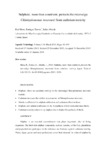Mostrar o rexistro simple do ítem
Sulphate, more than a nutrient, protects the microalga Chlamydomonas moewusii from cadmium toxicity
| dc.contributor.author | Mera, Roi | |
| dc.contributor.author | Torres, Enrique | |
| dc.contributor.author | Abalde, Julio | |
| dc.date.accessioned | 2016-07-29T16:12:30Z | |
| dc.date.available | 2016-07-29T16:12:30Z | |
| dc.date.issued | 2014-03 | |
| dc.identifier.citation | Mera, R., Torres, E., Abalde, J., 2014. Sulphate, more than a nutrient, protects the microalga chlamydomonas moewusii from cadmium toxicity. Aquat. Toxicol. 148, 92-103. doi:10.1016/j.aquatox.2013.12.034 | es_ES |
| dc.identifier.issn | 1879-1514 | |
| dc.identifier.uri | http://hdl.handle.net/2183/17152 | |
| dc.description.abstract | Sulphur is an essential macroelement that plays important roles in living organisms. The thiol rich sulphur compounds, such as cysteine, γ-Glu–Cys, glutathione and phytochelatins participate in the tolerance mechanisms against cadmium toxicity. Plants, algae, yeasts and most prokaryotes cover their demand for reduced sulphur by reduction of inorganic sulphate. The aim of this study was to investigate, using a bifactorial experimental design, the effect of different sulphate concentrations in the nutrient solution on cadmium toxicity in the freshwater microalga Chlamydomonas moewusii. Cell growth, kinetic parameters of sulphate utilization and intracellular concentrations of low-molecular mass thiol compounds were determined. A mathematical model to describe the growth of this microalga based on the effects of sulphate and cadmium was obtained. An ANOVA revealed an interaction between them, 16% of the effect sizes was explained by this interaction. A higher amount of sulphate in the culture medium allowed a higher cadmium tolerance due to an increase in the thiol compound biosynthesis. The amount of low-molecular mass thiol compounds, mainly phytochelatins, synthesized by this microalga was significantly dependent on the sulphate and cadmium concentrations; the higher phytochelatin content was obtained in cultures with 4 mg Cd/L and 1 mM sulphate. The maximum EC50 value (based on nominal cadmium concentration) reached for this microalga was 4.46 ± 0.42 mg Cd/L when the sulphate concentration added to the culture medium was also 1 mM. An increase in the sulphate concentration, in deficient environments, could alleviate the toxic effect of this metal; however, a relative excess is also negative. The results obtained showed a substrate inhibition for this nutrient. An uncompetitive model for sulphate was chosen to establish the mathematical model that links both factors. | es_ES |
| dc.language.iso | eng | es_ES |
| dc.publisher | Elsevier | es_ES |
| dc.relation.uri | http://dx.doi.org/10.1016/j.aquatox.2013.12.034 | es_ES |
| dc.subject | Sulphate | es_ES |
| dc.subject | Cadmium | es_ES |
| dc.subject | Low-molecular mass thiol compounds | es_ES |
| dc.subject | Tolerance | es_ES |
| dc.subject | Chlamydomonas moewusii | es_ES |
| dc.subject | Toxicity | es_ES |
| dc.title | Sulphate, more than a nutrient, protects the microalga Chlamydomonas moewusii from cadmium toxicity | es_ES |
| dc.type | info:eu-repo/semantics/article | es_ES |
| dc.rights.access | info:eu-repo/semantics/openAccess | es_ES |
| UDC.journalTitle | Aquatic Toxicology | es_ES |
| UDC.volume | 148 | es_ES |
| UDC.startPage | 92 | es_ES |
| UDC.endPage | 103 | es_ES |






